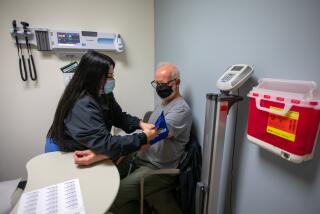The medicalization of life
- Share via
Here’s a question that’s not being asked in the healthcare debate: How much medical care do we want in our lives? It’s something we should be discussing.
Start with the two life events we all experience, birth and death.
My profession has gotten pretty good at terrifying (and operating on) pregnant women during what should be one of the greatest experiences in life. And we are equally proficient at dragging the elderly through all sorts of misery on the road to death.
Too harsh, you say?
Consider this. Two of the most common tests preformed on pregnant American women are obstetrical ultrasound and electronic fetal monitoring. After reviewing experimental studies involving more than 27,000 women, the Cochrane Review -- an independent, international collaboration that summarizes evidence for medical procedures -- found that routine late-pregnancy ultrasound “does not confer benefit on mother or baby.”
But it does do a good job of scaring expectant parents. Among other things, it finds minor anatomical abnormalities (like “bright spots” in the heart or intestine) that have been associated with feared genetic disorders such as Down syndrome. Less than half of maternal-fetal medicine specialists reported using the test to screen for these disorders in 2001; now almost all do. The problem is that the minor anatomical abnormalities are about 30 times more common than the genetic disorders they have been associated with.
That means most parents who are told after an ultrasound that their child might have serious problems are told so needlessly. Not surprisingly, this leads to a lot of unnecessary heartache and extra testing. This has led one of the founders of the technology to write that its routine use has crossed the line and now causes “more harm than good.”
The story is no better for electronic fetal monitoring during labor. Largely confined to teaching hospitals during the 1960s and ‘70s, by 1999 -- the last time the federal government examined the topic -- electronic fetal monitoring was used in 83% of all U.S. births. After reviewing experimental studies involving more than 37,000 women, the Cochrane Review found that the monitoring had no effect on the need for neonatal intensive care or, more important, infant survival.
It did lead to slightly fewer seizures, but also to a lot more Cesarean sections -- on the order of 100 extra C-sections to avoid one seizure.
The increase in fetal monitoring is part of the explanation for why the beginning of life now involves major surgery one-third of the time.
There is even more medical care at the end of life. Although most Americans say they would like to die at home, the most common place of death is still the hospital.
A hospital is not a peaceful place. The prevailing paradigm is intervention, not comfort. Nowhere is this more true than in intensive care units. They tend to be busy, noisy, frenetic and frightening places. There are lots of monitoring devices, which lead to lots of uncomfortable procedures. The ICU is not a good place to die.
Yet they are being used more and more for this purpose. Between 1995 and 2005, Dartmouth Atlas data show a 25% increase in the proportion of Medicare patients spending time in the ICU during their last six months of life. The average number of days spent in the ICU went up even more -- by 43%.
Furthermore, a startling number of doctors can be involved with care at the end of life. A third of Medicare patients cared for by “America’s Best Hospitals” (as designated by U.S. News & World Report) were seen by 10 or more physicians during their last six months of life. That’s right, 10 or more. It’s hard to imagine how that can ever be good. These may be our best hospitals, but they are certainly not our best deaths.
So the most fundamental life events -- birth and death -- increasingly involve more and more medical care. Why should you care about this increasing medicalization of birth and death?
Simple. Because it exemplifies the medicalization of life. Everyday experiences get turned into diseases, the definitions of what (and who) is normal get narrowed, and our ability to affect the course of normal aging get exaggerated. And we doctors feel increasingly compelled to look hard for things to be wrong in those who feel well.
Medicalization is the process of turning more people into patients. It encourages more of us to be anxious about our health and undermines our confidence in our own bodies. It leads people to have too much treatment -- and some of them are harmed by it.
And it’s big part of the reason why medical care costs so much.
There are many areas in which medical care has a great deal to offer. But it has now gone well beyond them. There may have been a time when the words “Do everything possible” were indeed the right approach to medical care. But today, with so many more possibilities for intervention, that’s a strategy that is increasingly incompatible with a good life. We all need to be a little more skeptical and -- to really be healthy -- willing to ask “Why?”
H. Gilbert Welch is an internist at the Department of Veterans Affairs in White River Junction, Vt., and professor of medicine at the Dartmouth Institute of Health Policy & Clinical Practice. He is the author of “Should I Be Tested for Cancer? Maybe Not and Here’s Why.”






